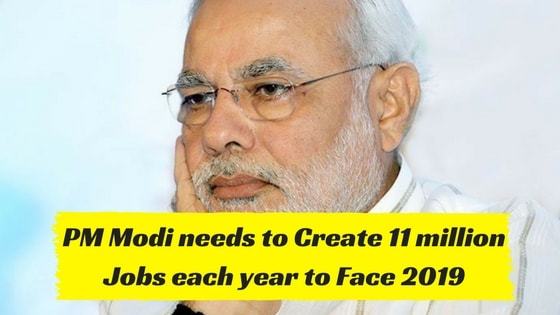Four years after Narendra Modi taking charge of India, with elections demanding answers, there is an urgency to place his jobs-record in the public domain. On that will depend whether Modi retains his job or not in 2019. Modi’s record on the jobs front is sketchy. There is skepticism on government numbers or the lack of government numbers. There is no clarity on the number of new entrants to the job market finding jobs every year. A report, for Different Truths.
For quite a while, Arvind Panagariya was deputy chairman of Niti Aayog. That was his ‘job’. Then, he quit this job and moved on. That is what happens. Most people with jobs are always looking for another job. Call it the ‘restlessness of the job or the restlessness of the job-seeker’, India’s job market is currently hot news. Four years after Narendra Modi taking charge of India, with elections demanding answers, there is an urgency to place his jobs-record in the public domain. On that will depend whether Modi retains his job or not in 2019.
Modi’s record on the jobs front, say his detractors, is sketchy. There is skepticism on government numbers or the lack of government numbers. There is no clarity on the number of new entrants to the job market finding jobs every year. Ask a parent and he will know what his freshly graduated son is up to: searching for a job or ensconced in one? The mother will pitch in with how much money her son’s contributing to the family income.
Most pundits, whose job is to crunch numbers, put the number of new job-seekers at 12 million a year – an average of a million a month. So the government’s job is to ensure the creation of 12 million jobs every 12 months. And by ‘jobs’ they mean ‘quality jobs’, not pakoda-peddler and paan-seller. Twelve million ‘quality jobs’. Gabbing on the phone in call centres is ‘quality job’. So is an appointment letter to join the team at Cognizant or TCS.
But while the opposition may ramp up laughs and score brownie points haranguing Tripura CM Bipleb Deb for his ‘pakoda-and-paan’ jobs-thrust, the tribe of pakoda and paan sellers, who range from north to south and east to west, will make it their job to vote against the opposition for looking down at their jobs with disparagement, downright contempt. The argument for ‘quality jobs’ comes with the premise that all job-seekers have not only quality qualifications but also the mojo to do specific quality jobs.
So, how many quality jobs have been created in Modi’s four years? Some say as many as 3.4 crores. The Niti Ayog counts the number of Mudra loan beneficiaries to arrive at a figure. But the debate is on ‘joblessness’. Panagariya in an article in The Times of India says, “Joblessness is a function not of the total number of people entering the 15-plus working age group in any year, but the number of people actively seeking a job and not getting it.”
To press home the point, Panagariya stresses that not all in the working age group want a job. It is the active workforce, with jobs and seeking one, that defines the extent of joblessness. The key number for Panagariya is the labour force participation rate (LFPR) or the percentage of those with jobs plus those actively seeking jobs divided by the working-age population.
“India is probably capable of generating around 6 million jobs without any real reform or labour laws or other incentives for job creation,” says an analyst. He adds that the “job creation engine faltered” under the twin impact of DeMo and GST. The real challenge, the analyst rubs in, is to get female work participation rates up. But that could be because he wants to divert the topic, to a ‘challenge’ the government faces, rather than to a ‘government-failure’. In an election year, apologists of the government will try to do just that. It is a matter of winning the perception battle. On that score, neither the government nor the opposition can be trusted.
The reality is the number of jobless/job-seekers at any one time is hard to figure. They include not just new entrants to the job market but also those seeking a job change. Like Panagariya during his tenure with Niti Ayog looking for a change. To the job-seeker, irrespective of whether he has one or is looking for one, a ‘quality job’ translates also to job-satisfaction which is a combination of many factors, from the paycheck to the number of paid holidays; to women, maternity leave and parity in pay!
Unemployment eats into the vitals of the nation as well as of the unemployed. It is characterized by daily dejection and dependence. An unemployed person mostly gravitates towards the opposition, hoping for a turn in fortune. The ruling party, if it cannot come up with credible job numbers, will find it hard to justify a demand to be given another five years, 60 months, to rule. The Modi government has very little time left to come up with the real jobs/joblessness numbers, and defend its jobs record.
Aditya Aamir
©IPA Service
Photo from the Internet





 By
By
 By
By

 By
By